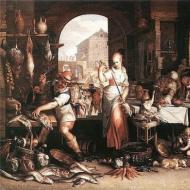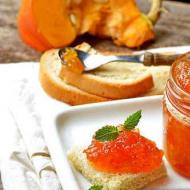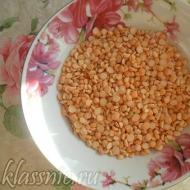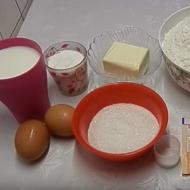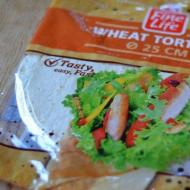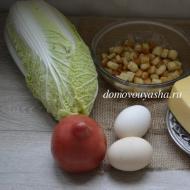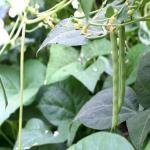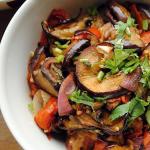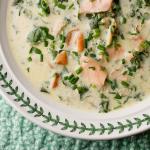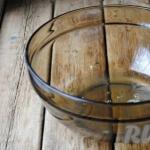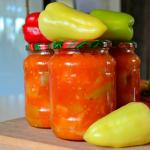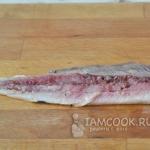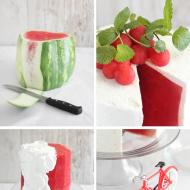
How to clean and cook porcini mushrooms. Porcini mushrooms: primary cleaning in the forest, proper processing before cooking. How to cut porcini mushrooms
Typically, future housewives receive knowledge about how to peel porcini mushrooms from their grandmothers and mothers. And the information is not always correct and reliable. Therefore, we suggest you learn how to properly peel porcini mushrooms in accordance with the canons of culinary technology. This information will allow you to get a correct idea of how to clean porcini mushrooms at home in such a way that there is as little waste as possible and as much recyclable raw materials as possible. The first thing to remember is that the processing of boletus mushrooms should begin immediately after they are collected in the forest. Before peeling fresh porcini mushrooms, prepare several bowls. Fill one of them with warm water. The other one should be adapted for slicing boletus mushrooms. The third one is for waste.
 Fresh mushrooms do not last long, so within 3-4 hours after collection they must be processed - sorted and prepared for canning or used for preparing mushroom dishes. If you cannot process the mushrooms right away, transfer them to an enamel bowl without a lid and store them in the refrigerator for 1–2 days. At the same time, they should be shaken and shifted as little as possible and handled carefully so as not to leave dark spots and dents. Preparing mushrooms for culinary processing involves clearing debris (adhered blades of grass and insects) and removing darkened or damaged areas.
Fresh mushrooms do not last long, so within 3-4 hours after collection they must be processed - sorted and prepared for canning or used for preparing mushroom dishes. If you cannot process the mushrooms right away, transfer them to an enamel bowl without a lid and store them in the refrigerator for 1–2 days. At the same time, they should be shaken and shifted as little as possible and handled carefully so as not to leave dark spots and dents. Preparing mushrooms for culinary processing involves clearing debris (adhered blades of grass and insects) and removing darkened or damaged areas.
 Before cleaning the porcini mushroom cap, clean it with a knife with a stainless steel blade or a soft cloth. The cut on the legs is updated, removing the most contaminated part. If mushrooms from the forest are heavily contaminated, they are soaked in water and pressed down with a weight to ensure complete immersion. After 10–20 minutes, the caps can be easily washed off from adhering grass and leaves. You should not leave mushrooms in water for a long time, as they will actively absorb it, which will ultimately negatively affect their taste and aroma and make the caps brittle. Then the mushrooms are washed with clean running water. Particular attention is paid to washing the lower surface of the mushroom caps, which can be spongy or lamellar, and therefore most susceptible to contamination. Then the mushrooms are left in a colander or sieve to drain the liquid. The exception is mushrooms intended for drying and, sometimes, freezing. They are only cleaned, but not washed with water, much less soaked.
Before cleaning the porcini mushroom cap, clean it with a knife with a stainless steel blade or a soft cloth. The cut on the legs is updated, removing the most contaminated part. If mushrooms from the forest are heavily contaminated, they are soaked in water and pressed down with a weight to ensure complete immersion. After 10–20 minutes, the caps can be easily washed off from adhering grass and leaves. You should not leave mushrooms in water for a long time, as they will actively absorb it, which will ultimately negatively affect their taste and aroma and make the caps brittle. Then the mushrooms are washed with clean running water. Particular attention is paid to washing the lower surface of the mushroom caps, which can be spongy or lamellar, and therefore most susceptible to contamination. Then the mushrooms are left in a colander or sieve to drain the liquid. The exception is mushrooms intended for drying and, sometimes, freezing. They are only cleaned, but not washed with water, much less soaked.
See how to clean the porcini mushroom in the photo, which shows the whole process step by step.


How to clean porcini mushroom
An important step is sorting and cleaning. For marinating in a hermetically sealed container, take only the boletus cap.
Porcini mushrooms intended for canning in hermetically sealed containers are also sorted by color or place of growth: spruce, pine, oak, birch mushrooms. In accordance with the distribution by variety, the stem is also cut off. The skin from the remaining stump near the cap is scraped off with a knife. In addition, mushrooms are thoroughly cleaned of adhering debris, needles, twigs, and particles of earth, and all wormy specimens are discarded. Wormholes are cut out of the less wormy ones. Mushrooms intended for drying are finally cleaned with a wet cloth, and the rest are washed.
How to clean porcini mushrooms before freezing
 Washing is the most important preparatory process. The quality of the finished products depends on its thoroughness. Therefore, special attention should be paid to washing, taking into account at the same time that during prolonged washing there is a loss of aromatic and soluble solids. Therefore, washing time must be limited.
Washing is the most important preparatory process. The quality of the finished products depends on its thoroughness. Therefore, special attention should be paid to washing, taking into account at the same time that during prolonged washing there is a loss of aromatic and soluble solids. Therefore, washing time must be limited.
You can wash the mushrooms well without loss for 10 minutes, changing the water several times. It is best to wash mushrooms in running and constantly changing water, especially with a high-pressure jet. Before cleaning porcini mushrooms before freezing, note that if the porcini mushrooms are excessively saturated with water, this indicates that they are overgrown or damaged. The decay process can produce substances harmful to health, such as the poison neurin, which can cause edible mushrooms to become poisonous. You cannot pull mushrooms out of the ground, because this disrupts the structure of the mycelium, after which the threads of the mushroom mycelium die off and do not bear fruit. Mushrooms must be carefully cut with a knife.
 After cutting the mushroom, check if it is wormy. In addition, by cutting off the mushrooms with a knife, we reduce the possibility of them becoming contaminated with stuck soil. Collected mushrooms are immediately cleaned of soil, leaves, pine needles, grass and other debris adhering to them; remove parts affected by insect larvae. Heavily contaminated lower parts of the legs are cut off. It is better to put mushrooms in the basket with their caps down - this way they are better preserved.
After cutting the mushroom, check if it is wormy. In addition, by cutting off the mushrooms with a knife, we reduce the possibility of them becoming contaminated with stuck soil. Collected mushrooms are immediately cleaned of soil, leaves, pine needles, grass and other debris adhering to them; remove parts affected by insect larvae. Heavily contaminated lower parts of the legs are cut off. It is better to put mushrooms in the basket with their caps down - this way they are better preserved.
See how to clean porcini mushrooms before cooking with photos showing the intricacies of this process.


Cleaning porcini mushrooms before drying.
One of the simplest methods of processing mushrooms is drying. Porcini mushrooms (boletus mushrooms) are most suitable for drying. The mushrooms are carefully examined and cleaned with a knife to remove moss, leaves, pine needles and other forest debris. They discard randomly collected inedible and wormy parts, cut out the damaged parts, separate the caps from the stems, if the skin is easily separated from the pulp, it is removed. Wipe the mushrooms with a dry or damp cloth. They don't wash. After this, the thick legs are cut crosswise into circles up to 3 centimeters thick, and the thin ones lengthwise into two or four parts.
Typically, future housewives receive knowledge about how to peel porcini mushrooms from their grandmothers and mothers. And the information is not always correct and reliable. Therefore, we suggest you learn how to properly peel porcini mushrooms in accordance with the canons of culinary technology. This information will allow you to get a correct idea of how to clean porcini mushrooms at home in such a way that there is as little waste as possible and as much recyclable raw materials as possible. The first thing to remember is that the processing of boletus mushrooms should begin immediately after they are collected in the forest. Before peeling fresh porcini mushrooms, prepare several bowls. Fill one of them with warm water. The other one should be adapted for slicing boletus mushrooms. The third one is for waste.
 Fresh mushrooms do not last long, so within 3-4 hours after collection they must be processed - sorted and prepared for canning or used for preparing mushroom dishes. If you cannot process the mushrooms right away, transfer them to an enamel bowl without a lid and store them in the refrigerator for 1–2 days. At the same time, they should be shaken and shifted as little as possible and handled carefully so as not to leave dark spots and dents. Preparing mushrooms for culinary processing involves clearing debris (adhered blades of grass and insects) and removing darkened or damaged areas.
Fresh mushrooms do not last long, so within 3-4 hours after collection they must be processed - sorted and prepared for canning or used for preparing mushroom dishes. If you cannot process the mushrooms right away, transfer them to an enamel bowl without a lid and store them in the refrigerator for 1–2 days. At the same time, they should be shaken and shifted as little as possible and handled carefully so as not to leave dark spots and dents. Preparing mushrooms for culinary processing involves clearing debris (adhered blades of grass and insects) and removing darkened or damaged areas.
 Before cleaning the porcini mushroom cap, clean it with a knife with a stainless steel blade or a soft cloth. The cut on the legs is updated, removing the most contaminated part. If mushrooms from the forest are heavily contaminated, they are soaked in water and pressed down with a weight to ensure complete immersion. After 10–20 minutes, the caps can be easily washed off from adhering grass and leaves. You should not leave mushrooms in water for a long time, as they will actively absorb it, which will ultimately negatively affect their taste and aroma and make the caps brittle. Then the mushrooms are washed with clean running water. Particular attention is paid to washing the lower surface of the mushroom caps, which can be spongy or lamellar, and therefore most susceptible to contamination. Then the mushrooms are left in a colander or sieve to drain the liquid. The exception is mushrooms intended for drying and, sometimes, freezing. They are only cleaned, but not washed with water, much less soaked.
Before cleaning the porcini mushroom cap, clean it with a knife with a stainless steel blade or a soft cloth. The cut on the legs is updated, removing the most contaminated part. If mushrooms from the forest are heavily contaminated, they are soaked in water and pressed down with a weight to ensure complete immersion. After 10–20 minutes, the caps can be easily washed off from adhering grass and leaves. You should not leave mushrooms in water for a long time, as they will actively absorb it, which will ultimately negatively affect their taste and aroma and make the caps brittle. Then the mushrooms are washed with clean running water. Particular attention is paid to washing the lower surface of the mushroom caps, which can be spongy or lamellar, and therefore most susceptible to contamination. Then the mushrooms are left in a colander or sieve to drain the liquid. The exception is mushrooms intended for drying and, sometimes, freezing. They are only cleaned, but not washed with water, much less soaked.
See how to clean the porcini mushroom in the photo, which shows the whole process step by step. 


How to clean porcini mushroom
An important step is sorting and cleaning. For marinating in a hermetically sealed container, take only the boletus cap.
Porcini mushrooms intended for canning in hermetically sealed containers are also sorted by color or place of growth: spruce, pine, oak, birch mushrooms. In accordance with the distribution by variety, the stem is also cut off. The skin from the remaining stump near the cap is scraped off with a knife. In addition, mushrooms are thoroughly cleaned of adhering debris, needles, twigs, and particles of earth, and all wormy specimens are discarded. Wormholes are cut out of the less wormy ones. Mushrooms intended for drying are finally cleaned with a wet cloth, and the rest are washed.
How to clean porcini mushrooms before freezing
 Washing is the most important preparatory process. The quality of the finished products depends on its thoroughness. Therefore, special attention should be paid to washing, taking into account at the same time that during prolonged washing there is a loss of aromatic and soluble solids. Therefore, washing time must be limited.
Washing is the most important preparatory process. The quality of the finished products depends on its thoroughness. Therefore, special attention should be paid to washing, taking into account at the same time that during prolonged washing there is a loss of aromatic and soluble solids. Therefore, washing time must be limited.
You can wash the mushrooms well without loss for 10 minutes, changing the water several times. It is best to wash mushrooms in running and constantly changing water, especially with a high-pressure jet. Before cleaning porcini mushrooms before freezing, note that if the porcini mushrooms are excessively saturated with water, this indicates that they are overgrown or damaged. The decay process can produce substances harmful to health, such as the poison neurin, which can cause edible mushrooms to become poisonous. You cannot pull mushrooms out of the ground, because this disrupts the structure of the mycelium, after which the threads of the mushroom mycelium die off and do not bear fruit. Mushrooms must be carefully cut with a knife.
 After cutting the mushroom, check if it is wormy. In addition, by cutting off the mushrooms with a knife, we reduce the possibility of them becoming contaminated with stuck soil. Collected mushrooms are immediately cleaned of soil, leaves, pine needles, grass and other debris adhering to them; remove parts affected by insect larvae. Heavily contaminated lower parts of the legs are cut off. It is better to put mushrooms in the basket with their caps down - this way they are better preserved.
After cutting the mushroom, check if it is wormy. In addition, by cutting off the mushrooms with a knife, we reduce the possibility of them becoming contaminated with stuck soil. Collected mushrooms are immediately cleaned of soil, leaves, pine needles, grass and other debris adhering to them; remove parts affected by insect larvae. Heavily contaminated lower parts of the legs are cut off. It is better to put mushrooms in the basket with their caps down - this way they are better preserved.
See how to clean porcini mushrooms before cooking with photos showing the intricacies of this process. 


Cleaning porcini mushrooms before drying.
One of the simplest methods of processing mushrooms is drying. Porcini mushrooms (boletus mushrooms) are most suitable for drying. The mushrooms are carefully examined and cleaned with a knife to remove moss, leaves, pine needles and other forest debris. They discard randomly collected inedible and wormy parts, cut out the damaged parts, separate the caps from the stems, if the skin is easily separated from the pulp, it is removed. Wipe the mushrooms with a dry or damp cloth. They don't wash. After this, the thick legs are cut crosswise into circles up to 3 centimeters thick, and the thin ones lengthwise into two or four parts.
How to peel porcini mushrooms for freezing
Then we cut off all the excess from the mushrooms. We cut large mushrooms into pieces, and leave small ones whole. Then put the mushrooms in a colander and leave it there for several hours. The mushrooms must be dry. Place the mushrooms in bags or containers. Freeze and store at temperatures from –18 to –23 °C.
 Many housewives really like frozen fried mushrooms: they have the same taste and aroma, nutritional and vitamin properties as fresh ones. That is why recently, with the advent of new and improved types of refrigerators and freezers, this preparation method has become very common.
Many housewives really like frozen fried mushrooms: they have the same taste and aroma, nutritional and vitamin properties as fresh ones. That is why recently, with the advent of new and improved types of refrigerators and freezers, this preparation method has become very common.
Before frying, you need to know how to clean porcini mushrooms before frying: free them from earthen lumps, grass, remove the stems of some types, rinse several times in cold water, and when finished, dry them by laying them out on a towel, preferably in the open air. .
Watch how to properly peel porcini mushrooms in the video, which illustrates the entire technology step by step.
Not only the collection, but also the cleaning of porcini mushrooms has its own rules and peculiarities, no matter how surprising it may sound. There are certain canons in cooking and they must be adhered to. Peeling porcini mushrooms is not difficult, but you need to be careful. This is the only way to protect yourself and get maximum pleasure from your future boletus dish.
Features of the view
Porcini mushroom is included in the first category in terms of taste, with valuable nutritional composition, noble white and dense pulp, which does not darken when cut and during heat treatment.
The cap is brown, in light and dark shades depending on age, velvety to the touch, 7-30 cm in diameter, and in a particularly favorable climate it can be found even up to half a meter. The shape at a young age is hemispherical, straightens over time.






The leg is up to 12 cm, in some giants – up to 25 cm. Thickness is 7-10 cm. The shape is cylindrical, sometimes similar to a barrel or a mace. The color can be white or brown, sometimes a fine mesh pattern is visible.
The mushroom is found on almost all continents; it loves humidity and warmth, so it can appear, depending on the weather, in May and autumn.
Grows in any forest: coniferous, deciduous and mixed. It is a symbiont and forms mycorrhiza with oak, pine, spruce, fir, birch, hornbeam, and aspen. It is not fussy about soils; it can grow on sand and among mosses and lichens. Therefore, on the collected whites you can find pine needles, fragments of dry leaves, sand, and moss, depending on the location of the find.
General rules for cleaning porcini mushrooms
Regardless of the further use of porcini mushrooms, many actions after cutting them in the forest are the same for everyone. Therefore, there are general rules:
- The first thing to remember: cleaning all the mushrooms is an urgent matter; this is the first thing to do when returning from a “quiet hunt”. Boletus has a rather dense pulp, but the decomposition process is natural for all types. Therefore, a mushroom picker ideally has 3-4, maximum 5 hours to cope without losses.
 Collected mushrooms
Collected mushrooms



Subtleties of cleaning before frying and cooking
Boletus is exceptionally tasty when fried, as well as in famous soups, where it looks like white meat without losing its color when cooked.
The mushroom bodies of the house selected for these purposes are cleaned from surface debris with a knife blade, adhered pine needles and blades of grass are removed, and soil is scraped off the stem. Then you can wash them. If the mushrooms were collected in sandy areas, or, for example, in the rain, then they may be more contaminated than usual, and then it is recommended to soak them in water for a quarter of an hour, pressing down with something on top, so that staying in the water is effective - such soaking will separate sand and particles of earth.



After rinsing in running water, place the boletus mushrooms in a colander and allow excess liquid to drain. Next we work with a knife: we need to eliminate everything from the fruit that easily lags behind, scrape the leg, refresh the lower cut and check for worms, remove all dark spots of pulp.
Before frying, prepared mushrooms can be doused with boiling water; this will be a control rinse that removes final debris and kills microbes. Then let the water drain and air dry. That's it, the harvest is ready to use in your favorite frying recipe.
For cooking, you can also manipulate boiling water. Since white mushroom is a high-quality product (of course, if it is not collected in radioactive and chemically contaminated places), there is no need to additionally boil it before the main cooking, as is the case with mushrooms of lower categories.
Preparing for freezing and drying
The general rules in the case of drying and freezing change by one point: contact with water is excluded here. That is, neither quick rinsing nor, moreover, soaking is carried out. To remove dirt efficiently, use a cloth instead of water, slightly moistening it for better adhesion of debris, or a brush from a hardware store, or even an old toothbrush.
- first remove all large debris from the cap and stem, clean off the root part with a knife;
- remove all fragments that are beginning to rot or have darkened for another reason;
- update the cut, look inside the leg, usually the worminess begins there; remove the part of the fruit body eaten by worms;
- scrape the stem with a knife as a final finishing action.


At the end, you can go over the surface again with a cloth (a new one, not the one you used at the beginning of the cleaning process) and start cutting before drying or freezing.
Cleaning porcini mushrooms before salting and marinating
Usually small, strong mushrooms are chosen for preservation. Selected boletus mushrooms are brushed to remove large forest debris and soil, and then washed for 10-20 minutes, constantly changing the water, or even soaked in salted water with the addition of citric acid or vinegar. This action has two purposes:
- so that the mushrooms crunch from a properly prepared recipe, and not from sand - water removes sand from all the crevices of the fruiting body;
- Frequent washing and soaking in salt and acid kills possible bacteria, which are especially dangerous during cold pickling, when the mushrooms are not boiled at all before preservation.
 Soaking mushrooms
Soaking mushrooms
After thorough washing, the final stage will be cutting off all suspicious fragments, darkening, damage, stripping the stem, removing the pulp where it easily comes off. As a result, we get a white fruit body, ready for pickling or pickling.
Answers to common questions
Collecting boletus mushrooms is a pleasure, because everyone understands its value and rejoices at the “catch.” In order for cleaning to also please you, it is important to study its secrets and do this with an understanding of the usefulness of all manipulations.

Cleaning porcini mushrooms, and any other mushrooms collected in the forest, is a matter of incredible urgency, because over time their fruiting bodies lose moisture and taste. Ideally, it is better to carry out preliminary cleaning right in the forest, and upon arrival home, finally clean the crop from dust, soil and debris.
At first glance, cleaning does not present any particular difficulties, because you just need to scrape the stem and cap with a knife. But in fact, this process has several important nuances that will help not only preserve the freshness of the crop, but also its taste. In this article we will look at basic information regarding cleaning boletus mushrooms in the forest and at home before cooking.
How to clean porcini mushrooms
Boletus is called the real king of the forest, because it has a distinct smell, extremely pleasant taste and contains many useful nutrients. Naturally, in order for this perishable product to retain all its properties, it must be properly prepared, and the very first stage of cooking is cleaning.
It is better to remove large pieces of earth, needles or leaves immediately in the forest, directly during collection. This will make your task easier when you get home. In fact, cleaning boletus mushrooms is not particularly difficult, because they are large, with a fleshy leg and a large cap, from which it is easy to remove dirt (Figure 1).

To thoroughly clean your harvest, prepare a knife, large bowl, and paper towels ahead of time. You will also need an old dental rosary.
White cleaning looks like this:
- First, we clean the surface from large particles of debris: adhered leaves, pine needles or soil residues.
- We quickly rinse the boletus under running water and place it in a colander to drain. It is important that washing is not practiced if the mushrooms are intended for drying.
- Using a sharp knife, cut off the lower part of the leg. This will remove soil and dust particles from the surface.
- Gently wipe the cap and stem with a paper or cloth towel. This will help remove any water droplets or dust particles that may remain after washing.
- Next, you can rub the pulp with a toothbrush. It will help remove damaged pulp and even the smallest particles of debris.
 Figure 1. Cleaning boletus mushrooms
Figure 1. Cleaning boletus mushrooms
After this, you need to wash them again and start cooking them. In this case, it is advisable to cut the boletus along the length or cut its stem to check whether there are passages left by worms inside the fruiting body. Unfortunately, damaged mushrooms are not very tasty, so it is better to throw them away.
Cleaning porcini mushrooms after picking in the forest
“Silent hunting” is an activity that cannot be rushed. If you are already lucky enough to stumble upon a large family of boletus mushrooms, you should not headlong cut off all the mushrooms and immediately throw them into the basket. In the forest, immediately after collection, it is much easier to clean the legs and caps of large debris. This will make the job of returning home much easier.
After cutting, carefully inspect the mushroom. There should be no rotten pulp on it. If everything is in order with the boletus, proceed to preliminary cleaning. First, you need to cut off the bottom of the stem to check for worms in the flesh. If you find only one hole left by insects, you can simply cut it out and put the fungus in a basket. But, if there are two or more such moves, it is better to throw away the boletus.
Note: If you put a wormy specimen in a basket, the insect will not only continue to gnaw passages in it, but can also move onto other specimens, and part of the harvest will be spoiled.
After this, you can simply remove large debris from the stem and cap. Ideally, it is better to do this with an old toothbrush with soft bristles, but most mushroom pickers prefer to remove leaves and needles simply by hand, and do the final cleaning at home.
How to clean porcini mushroom at home
When you come from the forest, you need to immediately start cleaning, because over time they lose their elasticity and their taste.
If you have already pre-cleaned the boletus in the forest, all you have to do is walk over it with a brush or a damp towel, depending on what treatment you will be subjecting the crop to. For example, if you are going to fry, boil or pickle mushrooms, you need to not only peel them, but also rinse them thoroughly. But before drying, boletus mushrooms cannot be washed, as due to excess moisture they will not dry correctly.
Further manipulations with the harvest also depend on how you plan to cook. So, for heat treatment and freezing, both the cap and the stem must be cleaned, and large specimens must be cut into pieces of approximately the same size.
How to clean the cap of a porcini mushroom
Mushrooms spoil very quickly, so they need to be processed within 3-4 hours after collection. If you were unable to clean and prepare them for processing, simply transfer the harvest to an enamel container and place it in the refrigerator without covering it with a lid. This way, boletus mushrooms can be stored for another 1-2 days, but they should not be shaken or constantly moved, as this can damage the delicate pulp (Figure 2).
 Figure 2. Cleaning the caps
Figure 2. Cleaning the caps
The boletus cap does not need very thorough cleaning. It is enough to remove large debris from its surface and lightly wipe it with a damp cloth or an old toothbrush to remove dust. Unlike boletus, which has a sticky film on its cap, the surface of the boletus skin is velvety and pleasant to the touch.
If you do not plan to dry the mushrooms, you can rinse them under running water. This will remove any remaining dust and debris not only from the cap, but also from the stem. You need to wash the inside of the cap especially carefully, since this is where the most dust and debris accumulates.
Do I need to peel the stem of porcini mushrooms?
The boletus leg needs more thorough cleaning. First of all, you need to update the cut in its lower part, even if you did it in the forest. You need to trim the bottom of the leg in such a way as to capture particles of pulp along its entire circumference (Figure 3).
 Figure 3. Removing debris from legs
Figure 3. Removing debris from legs
Next, you need to lightly scrape the flesh of the leg. The movements should be light, since the main purpose of such peeling is to simply remove the skin without damaging the pulp. After this, simply wipe the crop with a damp towel or rinse under running water if you do not plan to dry the boletus mushrooms. At the final stage, the harvest should be placed in a colander and the remaining water should be allowed to drain.
How to clean porcini mushrooms before frying
Regardless of the amount of harvest, some of the mushrooms will in any case remain for frying, because it’s so nice to please your family with this delicious forest delicacy (Figure 4).
 Figure 4. Preparing boletus mushrooms for frying
Figure 4. Preparing boletus mushrooms for frying
In fact, cleaning boletus mushrooms before frying is no different from preparing boletus mushrooms for any other heat treatment. First you need to cut off the bottom of the leg and inspect whether there are passages left by worms in the pulp. The damaged parts are cut out, the cap is cleaned of dust and debris, and the outer skin of the stem is carefully peeled off. Next, the boletus mushrooms should be washed several times in running water. If you suspect that there may be worms in the pulp, briefly soak the boletus mushrooms in salted water. All the insects will crawl out and all you have to do is rinse them again under running water, cut them into arbitrary pieces and start frying.
How to wash and peel porcini mushrooms for freezing
Modern kitchen appliances, in particular freezers, allow you to enjoy boletus not only during the harvest season, but also in winter. Naturally, for this, the fruiting bodies need to be properly prepared and cleaned.
Unlike cleaning before salting or heat treatment, preparing boletus mushrooms for freezing includes mandatory washing and soaking in salted water. First, we carry out traditional activities: we clean the caps and stems from large debris, cut off the lower part of the stem and place the fruiting bodies in a large bowl or pan with salted water. The mushrooms should sit in this solution for about an hour. This will make it possible to remove insects, worms or insect larvae from the pulp that may be accidentally missed during the cleaning process (Figure 5).
Next, remove the boletus mushrooms from the salt water, rinse thoroughly and place in a colander. To make the frozen product truly tasty and aromatic, it is better to remove excess moisture from the surface. After this, it is enough to put them in bags or containers. Small specimens can be frozen whole, but large ones are better cut into several pieces.
 Figure 5. Preparing porcini mushrooms for freezing
Figure 5. Preparing porcini mushrooms for freezing
If you want to make a preparation that will be almost ready to eat after defrosting, it is better to cut the boletus mushrooms into small pieces, lightly boil them in water and place them in portioned bags or containers. As a result, you will receive a ready-made preparation that will help you prepare delicious fried mushrooms at any time of the year.
How to cut porcini mushrooms
During the process of drying, pickling, freezing or salting, it is advisable to sort boletus mushrooms by size, since small specimens cook much faster than large ones. Very large specimens are usually cut into one or several parts. It is better to do this along the cap and stem, then both after freezing and after drying, the product will look attractive (Figure 6).
 Figure 6. Slicing boletus mushrooms
Figure 6. Slicing boletus mushrooms
You can marinate and salt porcini mushrooms whole, but some housewives prefer to separate the stems from the caps. In fact, the process of cutting boletus mushrooms does not affect their taste in any way. Its main purpose is to make the pieces more uniform in size or to finally check the pulp for worms.
If you plan to boil and freeze mushrooms, it is better to cut them into approximately equal pieces. For example, the leg is cut into thick slices, and the cap is simply divided into several parts.
The process of cleaning porcini mushrooms is shown in more detail in the video.
Categories:// from 09/10/2019The porcini mushroom is valued all over the world; it is even considered one of the noble species of forest delicacies. To prepare this product deliciously, you need to know how to properly process and clean it. This will be discussed in the article.
White mushrooms
A mature specimen is distinguished by a large plate-shaped cap with a convex top. It can reach a diameter of 30 cm. The surface of the cap can be wrinkled and cracked. The skin does not separate from the pulp and has a dark yellow, red-brown or brown color. After rain the skin is shiny, but in dry weather it is matte.

The leg of the boletus is thick, has the shape of a cylinder or club, and reaches 10 cm in girth. It has a white surface with reddish inclusions. The pulp of the mushroom is juicy, the fibrous structure does not darken when cut. In its raw form it does not have a strong aroma, but when cooked it smells strong and pleasant. The taste of the pulp is rich, mushroom, with pronounced nutty notes.
Did you know? Biologists have determined that porcini mushrooms contain antibiotics that can be processed and effectively used to treat tuberculosis.
Where and at what time do they grow?
The distribution area of the boletus is quite wide: it covers almost all continents, with the exception of Australia and Antarctica. This type of mushroom is even collected in South Africa and cold Iceland. The porcini mushroom is unpretentious in choosing a mycorrhizal partner: the list includes both deciduous trees (alder, oak, birch) and coniferous trees (spruce, pine).
 The fungus likes to settle in damp mosses and lichens, dense thickets of grass, as well as on sandy, sandy loam and loamy soils.
The fungus likes to settle in damp mosses and lichens, dense thickets of grass, as well as on sandy, sandy loam and loamy soils.
The fruiting period extends from June to September inclusive. In the warm and humid southern climate, the harvest season begins in May and ends in October. The porcini mushroom grows both in large groups and singly.
How to properly collect and clean mushrooms in the forest
Proper collection of boletus mushrooms begins with choosing a place away from roads, industrial enterprises, and farms where chemicals hazardous to health may be used. Mushrooms have a large mycelium, stretching for tens of meters, with a good ability to absorb toxins. Therefore, it is necessary to go far into the forest from populated areas.
Important! The porcini mushroom has several doubles; when collecting, you need to pay attention to the cut of the pulp. In a good edible fruit it does not darken.
It is important to collect the product correctly, without harming nature:
 According to one version, this mushroom is called white because it does not need to be scrupulously cleaned.
According to one version, this mushroom is called white because it does not need to be scrupulously cleaned.
The raw materials collected according to all the rules of a mushroom picker are directly inspected and initially processed: adhering particles of soil, vegetation and dirt are removed. The rest of the preparation steps are done at home.
Processing at home
Depending on what dish will be prepared from the mushroom product, it is prepared accordingly. This is a fairly simple process, but it requires precision and concentration.
For cooking
If you plan to boil, fry or stew them, then you need to not only remove large debris, but carefully clean the boletus mushrooms with a knife. There may be wilted areas, traces of a slug or worm on different parts of the fruiting body. They need to be cut off and scraped out thoroughly.

After processing, the purified product must be washed. It is also advisable to soak the mushrooms, since small particles of dust and insects accumulate in the tubular layer. If you place the raw materials in salted water, after 10–15 minutes the debris will float to the surface.
After this, the water is drained and the boletus mushrooms are rinsed well. If darkening is detected on the stem or cap, this area must be treated again with a knife. Only after this are the mushrooms cut for further cooking.
Important! You need to clean the collected mushrooms no later than 5 hours after collection: the raw pulp quickly breaks down and loses its beneficial properties.
Before freezing
Before freezing, the raw materials are also thoroughly cleaned, but not washed, because the pulp has the properties of a sponge. If you wash a mushroom, the water under the influence of low temperatures will turn into ice and destroy the tissue of the product. Such boletus becomes tasteless, brittle and loses most of its beneficial properties. It is better to clean the hat and stem using a soft bristle brush and a damp cloth.
Video: how to freeze porcini mushrooms
Before drying
Drying mushrooms at home and pampering yourself with your favorite dishes all winter is the task of every mushroom picker. Dry raw materials have all the beneficial qualities of a fresh product, and also do not lose their taste and aroma. You can use dried boletus mushrooms in soup or stew, as well as for frying, stewing or baking.
Some boletus mushrooms can be ground into powder and used as a seasoning for vegetables, meat, poultry or side dishes. Before drying, only dry processing of raw materials is carried out without water or even wet wipes. The main task is to get rid of moisture, and not to add it to the pulp.
Boletus is a delicious product that belongs to the first taste category of mushrooms. The quality of dishes prepared with it is very high, but largely depends on the correct preparation of the product.
The porcini mushroom is the king among mushrooms. It is impressively beautiful, nutritious, convenient and easy to prepare. If some mushrooms require pre-soaking or cooking, then after cleaning the porcini mushroom can be immediately placed on a hot frying pan and fried.
And here the question arises for mushroom pickers, especially beginners: how to clean porcini mushrooms?
Preparatory stage – a trip for porcini mushrooms
If you are lucky enough to live in places where porcini mushrooms grow, and you decide to prepare them for future use, or at least cook mushroom soup, then you should take care of cleaning the mushrooms in advance.
After all, everyone knows how much time and nerves it takes to clean and wash mushrooms. And yet, with enviable tenacity, mushroom pickers, without thinking about the consequences, once in the forest, strive to quickly fill the basket with mushrooms. They get so excited that they forget about everything in the world! Even the fact that after such a promenade they will have to sit for a long time over a mountain of mushrooms and sort through, clean, wash...
But you can make your task easier and start processing (cleaning) mushrooms right in the forest.
To do this, when going for mushrooms, you need to take with you, in addition to a knife, a brush, as well as paper or waffle towels. Such a soft and small brush can be bought at any hardware store. Or purchase a toothbrush with soft bristles specifically for “quiet hunting”. A brush is useful for superficial cleaning of mushrooms, and towels are useful for wiping these mushrooms from dust and dirt. And of course, the basket must be clean - free of debris and last year’s leaves.
Stage two - cleaning porcini mushrooms... in the forest
Having found a mushroom, take your time, pick it, throw it into the basket and run for the next one. Carefully cut off the mushroom and inspect it from all sides. If there is no visible damage on it in the form of a rotten barrel or a cap bitten by local inhabitants, start cleaning it.
First, cut off the bottom of the leg, where most of the dirt accumulates. And at the same time, check whether the ubiquitous worms have made passages in the leg. If there is one “tunnel”, then it’s okay! Cut it out with a knife. After all, if you leave the mushroom as it is, the worm will not only continue its work in this mushroom, but will also crawl to the next one. But if there are several holes in the mushroom, then mercilessly throw it away!
Then look under the hat. Insects and other small animals often live there.
After this, use a brush to remove sticky blades of grass, pine needles and other forest debris from the cap. Also clean the stem of the mushroom. The leg is quite amenable to such manipulation, as it is dense, fleshy and elastic.
If you collect mushrooms for heat treatment (frying, boiling) or for pickling and salting, then this stage of cleaning can be considered complete.
If you are collecting mushrooms for drying, then, armed with a damp towel, carefully wipe the cap and stem of the mushroom. After all mushrooms intended for drying cannot be washed! Because porcini mushrooms, like a sponge, instantly absorb water, but take a very long time to give it back. If you try to dry washed mushrooms, you will most likely fail in the form of spoiled and moldy slices.
Now the clean and pre-processed mushroom can be sent to the basket and on its way to the next one. Or pick a few mushrooms, lay them out on the grass, clean them, put them in a basket and move on to the next mushroom family.
Video recipe for the occasion:
Of course, such mushroom picking takes many times longer. But in this way you will avoid the tedious cleaning of mushrooms at home, all the garbage and mushroom waste will remain in the forest, and you will not have to deal with cleaning the kitchen after processing the mushrooms.
The next step is washing the porcini mushrooms
When you get home, try to wash the porcini mushrooms right away. These are the ones you collected for cooking.
There is no need to soak porcini mushrooms, as this deteriorates their quality and leaches out many beneficial substances from them. Therefore, rinse them under running water, carefully brushing particularly dirty areas with a brush. The exception is mushrooms collected immediately after rain and that are very dirty.
Place these mushrooms in a bowl and soak for fifteen minutes in cold water with added salt. Firstly, all the debris will remain at the bottom or rise to the surface, and, secondly, the insects that have climbed under the cap will leave their shelter. Remove each mushroom from the bowl and rinse under running water.
The porcini mushroom can be quite large - up to twenty centimeters in diameter, so it needs to be cut. Cut the mushroom lengthwise into two halves and, just in case, inspect it again for the presence of wormholes.
Then use a knife to separate the cap and, if it is large, cut it into several pieces. If the leg is large, cut it too. Now the mushrooms are ready for heat treatment.
Cut the mushrooms into thin slices for drying, not washing them, and proceed as required by further instructions.
0
Fresh mushrooms, collected in the forest or bought at the market, need to be quickly prepared for culinary processing. Only then will they retain their taste and be elastic and aromatic.
Dishes made from properly peeled and chopped mushrooms turn out beautiful and appetizing.
The main rule is that cleaning mushrooms cannot be put off for too long. Cut mushrooms in a warm room deteriorate and quickly become flabby. They easily lose their unique forest spirit. After a trip to the forest, you need to get down to business as soon as possible.
If this is not possible, you can store your prey until the morning in the refrigerator or other cool place, for example, in a cellar.
What tool should I use to quickly clean?
 To do this you will need a small sharp knife. The thin tip is convenient for removing damaged areas and cleaning out debris. A sharp blade will cut fragile flesh easily and will not crumble it.
To do this you will need a small sharp knife. The thin tip is convenient for removing damaged areas and cleaning out debris. A sharp blade will cut fragile flesh easily and will not crumble it.
A damp cloth or paper towels are useful for wiping off dried-on dirt.
Mushroom juice contains substances that turn your fingertips black. Use gloves to protect your hands while working.
Prepare an empty container for clean mushrooms and water for washing.
Is it necessary to wash?
When washed, mushrooms absorb a lot of moisture and lose their taste. Therefore, it is better to limit yourself to dry cleaning where possible. Mushrooms that you are going to dry for the winter should not be wet under any circumstances; they can only be wiped with a damp cloth. Before frying, it is also better to do without washing, but if necessary, you can quickly rinse with water.
- cooking;
- pickling;
- marinating.
Mushrooms for pickling, which have a bitter taste, are soaked in cold water for one or two days, regularly replacing it with fresh water.
Preliminary processing
 The first stage of cleaning takes place in the forest. Large debris is removed from the found mushroom: twigs, leaves, pine needles. The root is cleaned with a knife from soil and sand or simply cut off to check for worms inside.
The first stage of cleaning takes place in the forest. Large debris is removed from the found mushroom: twigs, leaves, pine needles. The root is cleaned with a knife from soil and sand or simply cut off to check for worms inside.
Under no circumstances should you take unfamiliar varieties. Even one inedible mushroom in a basket can lead to poisoning.
Also leave very wormy, moldy and very old specimens in the forest. They will spoil the taste of food and can be harmful to health.
Mushrooms purchased in a store or market have already undergone primary purification. Only small debris or traces of soil remain on them. At home, such mushrooms should be sorted again, damaged areas should be trimmed and, if necessary, washed. After this, you can cook and eat them.
White
Porcini mushrooms are not only the most delicious, they are also easy to clean. They usually grow in light, dry places or in moss. For these noble beauties, the soil is only cut around the circumference of the root. It is enough to wipe the hat or fan it with a brush. Carefully cut off areas damaged by forest inhabitants.
White ones, which are only slightly affected by worms, can be used for harvesting for the winter. During the drying process, the worms do not eat the mushroom from the inside, but crawl out.
boletus
Boletus mushrooms are often wormy; to check, the tip of their stem is immediately cut off. For large specimens, for the same purpose, the cap is separated and cut in half. There may be worms at the bottom of the cap, even if the rest of the mushroom is not affected by them. Then the spongy layer is completely removed. The leg is cleaned with a knife, removing the top layer of skin, although some mushroom pickers believe that this is not necessary.
Older boletuses have legs that become hard and fibrous. In cooking, it is better not to use such parts at all.
The video shows how to properly clean boletus mushrooms.
Boletus
Boletus mushrooms are processed in the same way as boletus mushrooms. The top layer is scraped off the stem. There is no need to remove the skin from the cap; just wipe off the dirt with a cloth. The spongy bottom of the cap should be checked for the presence of worms and fungus gnat larvae. Boletuses are distinguished by the fact that they turn blue and then turn black when cut. To prevent this from happening, it is recommended to immediately throw the pieces into water after cutting.
 Cute mushrooms grow in large families, and it’s not easy to cope with a whole mountain of butter mushrooms. Difficulties arise due to the slippery film that covers the heads of the oil.
Cute mushrooms grow in large families, and it’s not easy to cope with a whole mountain of butter mushrooms. Difficulties arise due to the slippery film that covers the heads of the oil.
When cooked, it becomes rough and slightly bitter. Hats must be cleaned. To prevent the film from sticking to your hands, the butter is dried. Another popular way is to pour boiling water over them.
You can lubricate your hands with oil or wear gloves, otherwise the sticky skin will darken your fingertips.
Otherwise, young butterflies only have their legs trimmed. In older ones, you can lightly scrape the stem and remove the remnants of the collar under the cap.
Chanterelles
Red aromatic fungi are remarkable because they contain a substance that repels worms. They do not need to be peeled or any parts separated. For cleaning, only cut off the lower third of the stem with traces of soil. Chanterelles have a rather bizarre shape. Earth or needles get stuck between the plates, which are not easy to remove.
Fortunately, chanterelles can be washed in plenty of water. To make them more elastic and not break, they are doused with boiling water. This simplifies subsequent processing.
 For large champignons, remove the skin from the caps. This is done by simply moving the knife, from the edge to the center. You can leave the top layer on the caps of young mushrooms. If the legs of the champignons are too harsh, cut them shorter or remove them completely. The collar is edible and does not need to be peeled off.
For large champignons, remove the skin from the caps. This is done by simply moving the knife, from the edge to the center. You can leave the top layer on the caps of young mushrooms. If the legs of the champignons are too harsh, cut them shorter or remove them completely. The collar is edible and does not need to be peeled off.
When washed, champignons absorb water strongly and lose their taste. Try to do it dry and shake off all the debris with a cloth.
If that doesn’t work, you can quickly rinse and drain the champignons in a colander.
Oyster mushrooms
Oyster mushrooms are very convenient to clean. They grow on tree trunks, so grass and needles practically do not stick to them. These mushrooms are good only when they are young; when sorting, old specimens are immediately removed and put aside. Select for food those whose cap is no more than 10 cm. Cut off the bottom of the stem, damaged edges and dried places on the fruiting body. It is convenient to wash oyster mushrooms in a sieve under running water, but you can also soak them in a basin.
Honey mushrooms
Honey mushrooms with long thin legs grow on stumps and practically do not get dirty. You just need to collect leaves and needles from them and trim the tips of the legs. If the lower part of the leg is too harsh, it is also cut off. The skin is not removed from the cap. However, rotten and darkened areas must be removed.
 It is believed that saffron milk caps are the cleanest mushrooms, but they still need to be processed. Sticky blades of grass, twigs and needles are cleaned off with a brush or knife.
It is believed that saffron milk caps are the cleanest mushrooms, but they still need to be processed. Sticky blades of grass, twigs and needles are cleaned off with a brush or knife.
Saffron milk caps are often found on sandy soils; sand sticks to the roots and on the underside of the caps. It can be easily washed off along with other foreign particles by briefly soaking the saffron milk caps in a basin. When collecting in the forest, they are not pulled out of the ground by the roots, but immediately cut off with a knife. If you brought them home whole, then the roots will have to be cut off.
Milk mushrooms
The milk mushrooms are first simply washed and cleared of sand and other debris. They are then soaked in cold water for three days to remove the bitter taste. The water needs to be changed several times a day. Place the container with mushrooms in a cool place so that they do not sour. Using a brush, knife or hard sponge, scrape the soaked milk mushrooms until white. Then the damaged areas are finally washed and removed.
 First of all, the raincoats are washed, carefully rubbing off the dirt with your fingertips. The outer layer, similar to a soft shell, is separated from the pulp. For large mushrooms, it is convenient to remove this skin with a knife. For control, spherical fruiting bodies are cut in half. If the flesh is white and elastic, it can be eaten.
First of all, the raincoats are washed, carefully rubbing off the dirt with your fingertips. The outer layer, similar to a soft shell, is separated from the pulp. For large mushrooms, it is convenient to remove this skin with a knife. For control, spherical fruiting bodies are cut in half. If the flesh is white and elastic, it can be eaten.
Raincoats with a yellowish center should be thrown away. They are either old or damaged. Puffballs are not poisonous, but a mushroom with a bad taste will ruin the dish.
After dry cleaning, mushrooms can be stored in the refrigerator for a short time, but after washing, they must be cooked immediately. For soup, solyanka or preparations (except for drying), you can boil them for future use with a small amount of salt and then use them for several days.
To ensure that the culinary masterpiece subsequently looks beautiful, the mushrooms are carefully cut into pieces of equal size. The fibrous stems are cut crosswise, and the caps into triangular segments. Small mushrooms can be eaten whole; they look especially beautiful in jars with marinade. The goal of careful and proper processing is to preserve the valuable qualities of mushrooms in order to fully reveal them when preparing delicious dishes.

